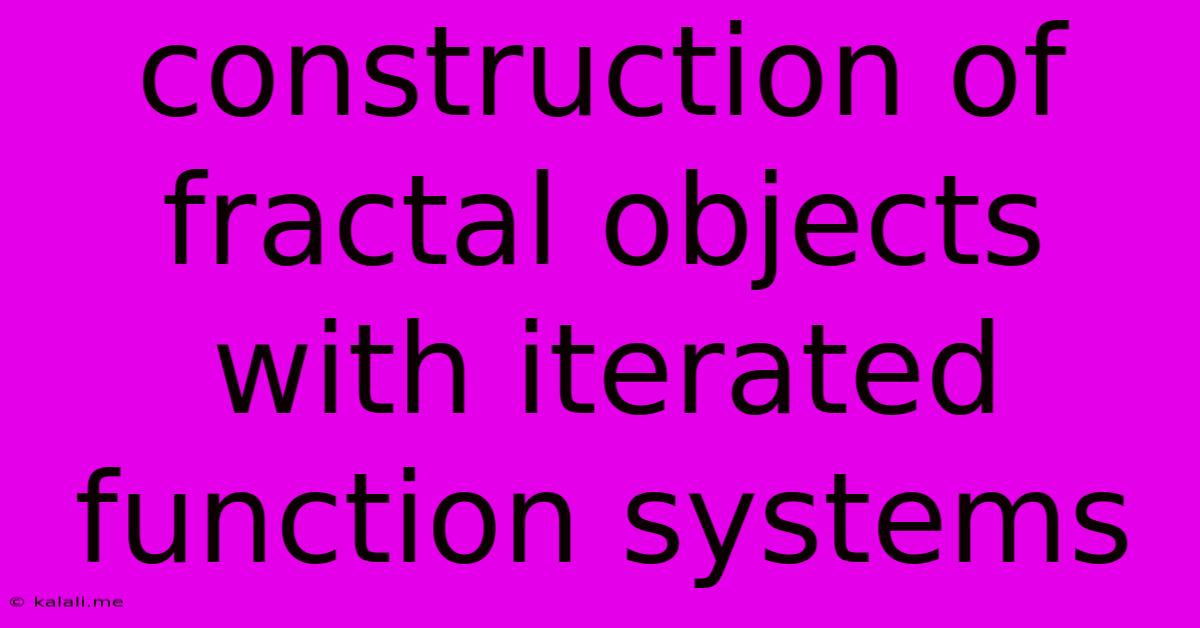Construction Of Fractal Objects With Iterated Function Systems
Kalali
May 23, 2025 · 4 min read

Table of Contents
Constructing Fractal Objects with Iterated Function Systems (IFS)
Meta Description: Explore the fascinating world of fractal generation! This article delves into Iterated Function Systems (IFS), explaining how simple mathematical transformations create complex fractal objects like the Sierpinski triangle and beyond. Learn the core concepts and practical applications.
Fractals—those infinitely complex, self-similar patterns found everywhere in nature, from coastlines to snowflakes—captivate mathematicians and artists alike. One powerful method for constructing these mesmerizing shapes is through Iterated Function Systems (IFS). This technique allows us to generate intricate fractals using a surprisingly simple process: repeatedly applying a set of mathematical transformations. This article will guide you through the core principles and practical aspects of building fractal objects with IFS.
Understanding Iterated Function Systems
At its heart, an IFS is a set of contraction mappings, each transforming a point in a geometric space (usually 2D or 3D) into a new point. These mappings are often affine transformations, meaning they involve a combination of scaling, rotation, and translation. The magic of IFS lies in the iterative application of these transformations.
Imagine starting with a single point. We apply one of the transformations from our IFS set at random. The resulting point then becomes the input for the next iteration, with another transformation chosen at random. This process is repeated countless times, generating a sequence of points. Remarkably, these points will eventually converge to form the characteristic shape of the fractal.
Key Components of an IFS
-
Affine Transformations: These are the core building blocks. Each transformation is defined by a matrix that performs scaling, rotation, and shearing, along with a translation vector that moves the point. The specifics of these matrices determine the shape of the resulting fractal.
-
Probability Weights: Each transformation in the IFS is usually assigned a probability weight. This weight dictates the likelihood of that transformation being chosen during each iteration. Adjusting these weights can significantly impact the fractal's appearance.
-
Iteration Count: The number of iterations directly affects the detail and complexity of the generated fractal. More iterations yield a more refined and detailed image, although computational time increases accordingly.
-
Initial Point: While the initial point's influence diminishes over many iterations, it can slightly affect the early stages of the fractal's formation.
Examples of Fractals Generated with IFS
Several iconic fractals can be easily constructed using IFS:
-
Sierpinski Triangle: This classic fractal is generated using three simple transformations, each scaling the input point by 0.5 and translating it to a different corner of an equilateral triangle.
-
Fern Fractal: The famous Barnsley fern is a more complex example, requiring four transformations to capture its intricate branching pattern. The probability weights assigned to each transformation are crucial in generating the characteristic density of the fern's leaves.
-
Other Fractals: Many other visually stunning and mathematically intriguing fractals can be generated by creatively designing the affine transformations and their probabilities. Experimentation is key!
Implementing IFS: A Practical Approach
While the mathematical underpinnings are crucial, the practical implementation is often surprisingly straightforward. Many programming languages offer libraries and tools specifically designed for generating fractals using IFS. These tools often handle the complex matrix operations and iterative processes, allowing you to focus on defining the transformations and probabilities. The visualization of the resulting point cloud is typically achieved by plotting the generated points, revealing the emergent fractal pattern.
Applications of IFS
Beyond their aesthetic appeal, IFS have several practical applications:
-
Image Compression: IFS can be used to compress images efficiently by representing them as a set of transformations. This technique is particularly effective for images containing self-similar patterns.
-
Computer Graphics: The ability to generate complex shapes with relatively simple rules makes IFS a valuable tool in computer graphics for creating realistic textures and backgrounds.
-
Modeling Natural Phenomena: The self-similarity found in many natural phenomena makes IFS useful in modeling various processes, from the growth of plants to the formation of coastlines.
Conclusion
Iterated Function Systems provide an elegant and accessible pathway to generating breathtaking fractal objects. Understanding the underlying principles of affine transformations, probability weights, and iterative processes unlocks a world of creative possibilities, allowing you to explore and construct intricate fractal patterns—a testament to the beauty of mathematics and its power in generating complex patterns from simple rules. Experiment, explore, and let the beauty of fractals unfold!
Latest Posts
Latest Posts
-
Tire Pressure Off Vehicle Vs On Vehicle
May 25, 2025
-
How Long Does It Take To Do An Alignment
May 25, 2025
-
Results Of Convergence Of Empirical Distribution To True Distribution
May 25, 2025
-
Bash Set Variable With Indirect Reference Name
May 25, 2025
-
Best Drill Bit For Stainless Steel
May 25, 2025
Related Post
Thank you for visiting our website which covers about Construction Of Fractal Objects With Iterated Function Systems . We hope the information provided has been useful to you. Feel free to contact us if you have any questions or need further assistance. See you next time and don't miss to bookmark.